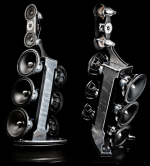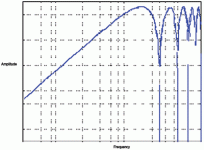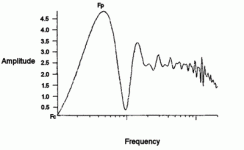1, an equal amount of some comes from the back of the cone as the front, this bounces around the cabinet until it is ether absorbed or escapes out through the cone, or the cabinet walls ( or one of those port things ) as delayed sound
2, the mechanical reaction of moving the cone shakes the speaker magnet, that vibrates the speaker chassis, and then the speaker cabinet, so it acts like a sound box
Bother to deal with those ( I think the reflected sound is the most important ) and you'll be rewarded with a very natural sound, with no " boxyness " what so ever.
2, the mechanical reaction of moving the cone shakes the speaker magnet, that vibrates the speaker chassis, and then the speaker cabinet, so it acts like a sound box
Bother to deal with those ( I think the reflected sound is the most important ) and you'll be rewarded with a very natural sound, with no " boxyness " what so ever.
Bafflestep and edge diffraction can definitely colour the midrange, as well as many of the effects already discussed.
Pardon me for living in flyover states. I have never seen or heard any of those brands. I've heard of Magnaspan, but never saw or heard one. Active equalization, except the bass & treble knobs on the preamp, is a concept invented after all the hifi stores died here. Last was Circuit City, that demoed car audio mostly in a 5 sided room. Buzz boxes for idiots. Dead about 2005.
Just not any good Hi-Fi stores out there in the corn fields, Joe? 😀
BTW, Magnepan is from way up in the wilds of Minnesota.
BTW, Magnepan is from way up in the wilds of Minnesota.
The good stuff, obviously. It's an acquired taste. I've owned all kinds of speakers, come to think of it; AR3s, VOTs, Polk SDAs, Acoustat panels, KEFs, Tannoys, Bostons, Wharfdales... These days it takes much much less to get off, than it did in 1970. That's an analogy! ;')What are all you OB fans smoking?
I no longer need rock band sound reinforcement levels of SPL performance; a couple of little 2" cones seem to throw a pretty captivating sound field in between and behind here in the bedroom. I do have 15"s with 18" in the livingroom, but at the SPLs I listen to, they barely move at all; the VC of the 15 on top probably never moves more than a single winding through the magnet gap, on the 18" bottom, maybe a couple few windings every once in a while. VC inductance change with displacement? What displacement? There isnt any...
Maybe OB is just something that happens when you get old...different properties begin to attract. I completely understand why they're not sold in stores. It's the opposite of where a buck to be made is; everything to the max.
https://www.diyaudio.com/community/threads/speaker-camp-2022-northern-california.384670/
Let's not forget OB from the master himself.
Let's not forget OB from the master himself.
I operate my VOT imitations at 1 Vav, or 1/8 watt into 8 ohms. They can peak at 50 W once a year when I play 1812 overture. They are sold to operate at 300 W rms, driving the customers in bars & clubs into a consumption frenzy. But the HD chart, 2nd & 3rd harmonic 20 db down from 5 W response, tells a hifi story. Other than that, the last good pair of speakers I heard were VOT's in Houston in 1966. Louisville Brown Theater has Meyer sound speakers the size of Fiat cars, that I found to have screechy violins during Swan Lake. Maybe the CD was recorded with cheap microphones.I've owned all kinds of speakers, I do have 15"s with 18" in the livingroom, but at the SPLs I listen to, they barely move at all; the VC of the 15 on top probably never moves more than a single winding through the magnet gap, on the 18" bottom, maybe a couple few windings every once in a while. VC inductance change with displacement? What displacement? There isnt any...
A few months back a guy on ebay sent me an offer for a pair of Peavey SP3s, which, in another time and place, I would have loved to have. My VOTs were actually Altec Valencias. I even added Peavey handles to the sides, to make them more SP3 like. I do remember running them at less than 1W for an enjoyable SPL. When I was 30! Those 811 horns threw a mighty tight soundstage; a friend remarked the guys voice sounded like it was coming off the front of the 31" tube Sanyo TV I had set in between. Center channel? Pffft!I operate my VOT imitations at 1 Vav, or 1/8 watt into 8 ohms.
I was fortunate as a teenager to have a friend who was into music and happened to have an older brother...who had a set of real VOTs in the basement, along with a TT and some Dynaco stuff, where I spent some time listening to music. Another friend's father had AR3s with Dynaco MKIIIs, anothers dad had Klipschorns with all McIntosh. Those were one-time experiences...a good grab on the "aural compensator" control (after asking permission) is all it takes!
I'm glad I got that early exposure, even though I didnt quite know what to do with it at the time. At least I knew where to look, later in life. Still looking around, trying different things, trying to minimize any compulsion to get up and out of the chair. Wife says "You're too comfortable".
I've had Meyer get rough in top when driven hard. Their crossovers have improved over the years. But a little surprising that you'd at those kind of levels in a cinema.Meyer sound speakers the size of Fiat cars, that I found to have screechy violins during Swan Lake.
My Altec VOTT A5 were a joy, never harsh or shrill. But they never had to work hard in my small listening room.
The way I've been...trying to imagine it...is by considering a perfectly uniform radiant point source in between and behind the OB panels. When the waves reach the speaker cones on the OB panel, they of course will will be pulled in and pushed out as they ride the pressure wave - just like any microphone diaphragm at the same positions would.
Now play that back. Does the OB arrangement put humpty-dumpty (the image of the point source) back together again? How is what it does, different than a closed box?
Now play that back. Does the OB arrangement put humpty-dumpty (the image of the point source) back together again? How is what it does, different than a closed box?
It seems the choice is broadband treatment in a box or no treatment in an OB. There seems to be nothing in between these choices. I can see why there are diehard camps.
It's a velocity source (relying solely on the driver's mechanical and magnetic attributes) with two poles (the rear out-of-phase) and no real leakage from that rear out-of-phase signal transmitting through the cone itself. Diffraction effects depend on the "baffle/no-baffle" design and are often enhanced (larger amplitude changes) within a certain bandwidth relating to the size of the baffle (or no baffle at all). Notably many open baffle designs are LARGER than most sealed designs in an effort to keep the two poles from interacting with significant reduction in spl as freq.s decrease.How is what it does, different than a closed box?
Closed box is a pressure source (relying on the driver's mechanical interaction with the air-load in the box and that interaction with the driver's magnetic attributes). Its a single pole and can have significant leakage from that rear out-of-phase signal transmitting through the cone. Diffraction effects here are often less significant (in amplitude changes) for a given baffle size, BUT are typically higher in freq. as a result of a smaller box/baffle (relative to a larger open baffle design).
IF you can come close to removing that air-load (as with a very low-loss box interior and a wildly large volume relative to the driver's Vas) and come close to removing the rear out-of-phase leakage (often by virtue of having such a large box with interior rear panel and its absorptive material well away from the driver), THEN you are largely left with the polar difference (which is freq. dependent and has diffraction differences). A "radial" design (like an up-firing design) can typically improve on this with fewer noticeable diffraction effects as freq.s rise - providing a "cleaner" overall polar result (within a limited high freq. bandwidth) approximating omni-polar.
Note: perceptually broad-band (extending up to as high as 7 kHz with pressure relatively near the average) Omni-polar is actually closer to a double-pole open baffle than is the typical closed box design because you have significant pressure at higher freq.s at -180 degrees (even though out-of-phase).
^^ Leaky box fits between.
There is two reasons why use a box: to reduce sound to backside (monopole), and to boost bass. OB radiates to backside (dipole) and loses the bass due to interference. Leaky box can be made so it reduces sound to backside but it also loses the bass. Difference is mostly in pattern, but also in box problems because we vent the back side out intentionally and make good use of it.
There is two reasons why use a box: to reduce sound to backside (monopole), and to boost bass. OB radiates to backside (dipole) and loses the bass due to interference. Leaky box can be made so it reduces sound to backside but it also loses the bass. Difference is mostly in pattern, but also in box problems because we vent the back side out intentionally and make good use of it.
I frequently wonder the same thing.What are all you OB fans smoking?

Then I remember that there are also people who like face-tattoos, nipple-piercings, lutefisk, and kiviak. (Lutefisk is a gelatinous mass of whitefish preserved in lye. Kiviak is fermented dead bodies of decomposing Little Auks (birds) stuffed into a seal-skin bag, feathers, feet and all.)
Quite possibly there are Internet forums where people gather to show off their latest face-tattoo, and be congratulated on it. Quite possibly there are online forums where people discuss their enjoyment of nipple-piercings, lutefisk, and kiviak.
"There's nowt as queer as folk", as the old saying goes. (And "queer" simply means "strange" here. It has nothing at all to do with its more modern usage regarding gender identity or sexual orientation.)
To me, speakers mounted on open baffles are very much a case of "Throwing out the baby with the bath-water", to use another old English expression. Trading off most of the bass response and power handling, along with flat frequency response, along with low-frequency THD, in order to get rid of "boxy" sounds seems like a very poor trade off to me. On top of that, stereo imaging tends to be poor, in my experience, probably because of the big wash of uncontrolled reflected sound arriving from walls, ceiling, and floors in every direction, randomly delayed, and randomly attenuated.
Not that I like boxy sounds - not at all. There are many "boxy" sounding speakers out there, and I can't stand them. Many that I know of are from the world of music electronics, like the very boxy-sounding Fender Blues Junior, or the boxy Vox AC4-TV.
But every day I listen to a pair of Alesis studio monitors that don't sound the least little bit "boxy". The enclosures are pretty small, the walls are thick MDF, the interior is carefully stuffed with an optimum amount of acoustic stuffing, and there's bracing in the right places inside the box.
Most importantly, the acoustic output of the speakers was measured, over and over, with precise and sensitive equipment; vibrating box panels or reflected interior sound, if any, is picked up by the measurement microphone, and it shows up in the measured frequency and impulse response. And that means you can track down the source, and eliminate it, by modifying the panel thickness, dimensions, bracing, or internal stuffing.
Every good studio monitor loudspeaker I know of consists of drivers mounted in boxes. Unlike consumer "Hi-Fi" speakers, where anything goes if the ad copy can sell it, studio monitors actually have to be good; they have to reveal what's in the mix as recording,mixing, mastering, and broadcast engineers listen critically to music. I pay no attention to Hi-Fi fads and fancies; but I know good studio monitors really are good loudspeakers, so I paid attention to them, and to what their designers taught me, while I had the opportunity to do so.
The popularity of open-baffle speakers in DIY audio circles isn't the only odd speaker-related phenomenon. Another even weirder one is the popularity of small "line array" speakers for home music listening and small portable P.A. systems. Every one of these that I've listened to sounds quite bad, very "shrieky", very much like a room full of televisions all turned up very loud; which is pretty much what these speakers actually are, as they often use small "full-range" drivers designed for televisions. These cheap drivers are anything but full-range, and the frequency response is anything but flat. They are designed to provide mediocre audio from very small enclosures, while the picture on the TV screen distracts the listener's brain and keeps them from noticing how appallingly bad the audio quality is.
In these line-array speakers, the coup de grâce (death-knell) to any kind of audio quality comes from mounting several of these already nasty-sounding drivers in a long tube-like enclosure, which usually has plenty of nasty shrieky pipe resonances of its own, which are added to the peaky, shrieky sounds of the little speakers. Shriek upon shriek, peak upon peak. The end result is usually closer to an auditory disaster than an auditory joy, at least for me.
Possibly the most unpleasant auditory experience I've had in recent years happened just before the pandemic, in 2019, when I walked into a college quadrangle with a popular-brand "line array" P.A. system pumping out music at one corner. The add-on subwoofer was also placed in the same corner. But what my ears heard was midrange and high frequencies uniformly arriving from every direction of the compass, with no detectable direction of origin, while the bass thumped away soggily from one corner of the large quadrangle. Disorienting and unpleasant, this was the audible equivalent of watching a corpse with a freshly severed head, head still screaming from one location, feet wildly kicking from 50 feet away.

Now, I have nothing against people who like face-tattoos, nipple-piercings, lutefisk, or kiviak. But if I were to accidentally stumble into a room - or an Internet forum - where people were discussing these things with great enjoyment, I would be baffled and bewildered, unable to understand or empathize with their viewpoints.
I would also be baffled at the lack of any critical discussion or counterarguments regarding the wisdom of participating in these cultural oddities. (People have been struck down with botulism from eating kiviak, and like it or not, a face-tattoo more or less guarantees that many career paths will be shut down to you.)
For me, it's much the same for open-baffle speakers, and line-array speakers. I can't really empathize with those who love them, and I marvel at the fact that the many serious failings of these speaker types are rarely if ever discussed. As the Internet increasingly disconnects subjective opinions from hard-won engineering facts, the known limitations and failings of these speakers are increasingly lost to the past. Perhaps we have come to regard Taylor Swift as a fine example of a singer, forgetting Kathleen Battle, Kiri Te Kanawa, and Anni-Frid Lyngstad ( before she was in ABBA:
The first two attached images show, respectively, theoretical frequency response for a point source mounted at the centre of a circular baffle, and an actual measured frequency response of a 100-mm (4-inch) driver in a 300mm (12 inch) circular baffle. The only good words to describe either frequency response are "awful", or perhaps "horrible", or "atrocious".
The next two images show a face-tattoo, and kiviak. You decide for yourself the best words to describe those. I won't touch that with a ten-foot pole. 😀
It's true that changing to a non-circular baffle, and offset-mounting drivers, make the awful frequency responses slightly less awful. But throwing away the OB and mounting the driver in a box of the right volume, properly built, braced, stuffed, and measured, will give you a vastly less-awful frequency response. And a good (read: flat) frequency response is the single best thing you can have if you want better speaker sound.
-Gnobuddy
Attachments
😀 Like with anything there can be misunderstanding, holding the hammer backwards and still getting the job done 😀
Like face tattoos OB is not for all applications but for some they should work very well. Frequency response graphs don't tell about psycho acoustics. For OB one uses (or should use, many try misuse) the part below diffraction (or dipole null) and have sufficiently many ways (4+) and woofers to get full bandwidth SPL capability, no diffraction, no coloration from the speaker structure at all since the drivers can be positioned at null of each other. Yes, many drivers and big, probably DSP and many amplifiers, expensive. Baffle is unnecessary, just naked drivers. What is needed from such system then is sufficiently large room where the back radiation does not interfere where it would matter, if the speakers are positioned so it does not arrive as first reflections but for the late reverberant field I see no downside. They have constant directivity, no box sound, no diffraction (crossed below diffraction), possibly reduced early reflections. Should make very good system, no other problems than finding the cash and big dedicated room. Never heard any OB systems though 😀
Of course most pictures of OB systems are not made and positioned as described but neither are most boxed speakers either! By the way boxed systems would benefit crossing over before diffraction as well, having DSP and multiple ways 😉 Common thing here is that the system should fit the application, sometimes closed box would work better than OB, some times other way around. If system has to be small then boxed is the way to go, no other way to get some wide bandwidth SPL out from it. Closed speakers need to also be quite big before good full bandwidth SPL comes reality. If it can be a big system it is about the room what works better. Some people still like all kinds of systems, limited SPL and bandwidth.
Like face tattoos OB is not for all applications but for some they should work very well. Frequency response graphs don't tell about psycho acoustics. For OB one uses (or should use, many try misuse) the part below diffraction (or dipole null) and have sufficiently many ways (4+) and woofers to get full bandwidth SPL capability, no diffraction, no coloration from the speaker structure at all since the drivers can be positioned at null of each other. Yes, many drivers and big, probably DSP and many amplifiers, expensive. Baffle is unnecessary, just naked drivers. What is needed from such system then is sufficiently large room where the back radiation does not interfere where it would matter, if the speakers are positioned so it does not arrive as first reflections but for the late reverberant field I see no downside. They have constant directivity, no box sound, no diffraction (crossed below diffraction), possibly reduced early reflections. Should make very good system, no other problems than finding the cash and big dedicated room. Never heard any OB systems though 😀
Of course most pictures of OB systems are not made and positioned as described but neither are most boxed speakers either! By the way boxed systems would benefit crossing over before diffraction as well, having DSP and multiple ways 😉 Common thing here is that the system should fit the application, sometimes closed box would work better than OB, some times other way around. If system has to be small then boxed is the way to go, no other way to get some wide bandwidth SPL out from it. Closed speakers need to also be quite big before good full bandwidth SPL comes reality. If it can be a big system it is about the room what works better. Some people still like all kinds of systems, limited SPL and bandwidth.
Last edited:
I cant. The concept I'm trying to wrap my head around falls apart then, when I look at graphical representations of dipoles sound pressure radiation. I can only take it as far as the dipole nature of a driver on an open panel being similar to a ribbon mic. Which is a dipole, sometimes called a "velocity" mic. ScottG above called OB a velocity source, versus a pressure source.Could you draw that or describe it another way?
Closed boxes being pressure sources makes sense, particularly when one of those cars drives by where the bass flys right through the house walls like they're not even there. "Velocity" or OB bass just doesnt do that, travels_for_miles thing.
I only stayed in acoustic test during my career for a short time, barely picking up sound pressure vs sound power. I never grasped velocity vs pressure and they had a sound intensity mic available (which was a sort of dipole mic), but I never got a good working knowledge of what sound intensity exactly was. All they cared about was the sound power emitted by a desktop PC or fan.
Now how one hears things like velocity or intensity and how that sounds versus pressure...nope. I dont have an answer. Nor how sound reproduced as a "velocity" puts together a 3D soundstage versus how sound pressure would do it - nope, quite beyond me to explain.
There's only anecdotal stuff that some people like OB, and ribbon mics are coming back into vogue for some reason; maybe people like the way they sound. I have a vague flicker that the intensity mic nulled out the ambient environment for a better measurement of something that couldnt be moved inside the anechoic chamber.
It's interesting to consider musical instruments. Kick a bass drum - pressure wave - no doubt. What's a cymbal then? A violin, with its top side and back side connected by a stressed sound peg inside it? Must be some trick to reproduce these things when some of them are pressure sources - like a horn - and some are velocity like a dipole radiator. Put that with the ear (possibly) hears pressure and velocity in different ways; no wonder there's so much thrash across speaker designs trying to get it "right".
To describe pressure vs velocity is to describe Voltage vs current. You can't have one without the other and when it comes to sound, the goal is the same for both kinds of speaker. Therefore, apart from the practical differences like excursion and EQ, the real difference is the radiation pattern and room interaction.
- Home
- Loudspeakers
- Multi-Way
- Why does a drive unit sound so different when placed in an enclosure?




